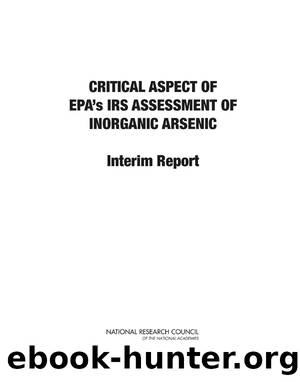Critical Aspects of EPA's IRIS Assessment of Inorganic Arsenic by National Research Council

Author:National Research Council
Language: eng
Format: epub
Tags: Environment and Environmental Studies: Pollutants and Toxics
ISBN: 9780309297097
Publisher: The National Academies Press
Published: 2013-11-07T00:00:00+00:00
FIGURE 4 Cadmium-induced shift in GFR distribution at a chronic exposure of 1 μg/kg per day relative to a 47.8- year-old female baseline. Source: Ginsberg 2012. Reprinted with permission; 2012, Journal of Toxicology and Environmental Health, Part A: Current Issues.
⢠Those who are at high risk for a disease (they are genetically predisposed or preclinical markers are present) may be more likely to get the disease if exposed to arsenic. Evidence of that would ideally involve prospective studies that include assessment of a preclinical biomarker, arsenic exposure, and disease incidence over time. Without such evidence, it may still be possible to estimate the increased risk of disease (such as chronic renal disease or myocardial infarction) by evaluating how arsenic shifts the population distribution of preclinical biomarkers (such as GFR or heart-rate variability).
⢠It may be impossible to find a threshold of an arsenic-induced increase in disease in the population because a large number of people are in a preclinical state and would be sensitive to the low end of the doseâresponse curve. For that to be evident, the epidemiology data would need to characterize the relationship between arsenic exposure and risk of disease in a broad cross-section of the population (or look at precursor lesions or key events) and allow a robust examination of a lowâdose slope.
⢠Whether the potential for arsenic interaction with disease processes differs between the populations from which the doseâresponse data are derived and the US population as a whole needs to be considered.
On the basis of the degree of evidence on a vulnerable subpopulation, consideration should be given to whether doseâresponse assessment will focus on the population as a whole or will involve separate assessments for the general population and susceptible subgroups. If it is the population as a whole, the traditional approach is to address variability with uncertainty factors; it may also be possible to analyze the effect of variability on risk by evaluating how the risk distribution of the disease shifts in response to arsenic. In essence, the risk distribution based on a subclinical biomarker is an expression of toxicodynamic variability that can be captured in doseâresponse assessment (NRC 2009; Ginsberg 2012).
The alternative approach is to address vulnerable subpopulations as separate from the general population and assign them unique potencies via doseâresponse modeling specific to the groups that might be based on actualâdose response data for the groups, on adjustments for specific toxicokinetic or toxicodynamic factors, or on more generic adjustment or uncertainty factors. An example of a generic approach is the application of age-dependent adjustment factors for heightened cancer potency in young children compared with adults in the case of mutagenic carcinogens (EPA 2005a). For arsenic, if it is known that a particular age group, disease (or disease-related end point), genetic variant, or coexposure creates unique vulnerability, efforts should be made to estimate the potency differences relative to the general population and on that basis to consider developing separate potency values or basing a single IRIS value on the most sensitive group or on the overall population with adjustments for vulnerable groups.
Download
This site does not store any files on its server. We only index and link to content provided by other sites. Please contact the content providers to delete copyright contents if any and email us, we'll remove relevant links or contents immediately.
Human Diseases (MindTap Course List) (by Team-IRA) by Marianne Neighbors Ruth Tannehill-Jones(844)
The Neglected Dimension of Global Security: A Framework to Counter Infectious Disease Crises by National Academy of Medicine Secretariat(421)
Statistical Methods in Health Disparity Research by J. Sunil Rao(399)
Imaging in Urology by Mitchell Tublin MD Joel B Nelson MD(394)
Short Course in Medical Terminology by Nath Judi L.;(331)
Cancer Cell Culture by Unknown(304)
Wilkins' Clinical Practice of the Dental Hygienist by Boyd Linda D.;Mallonee Lisa F.; & Lisa F. Mallonee(301)
Clinical Research in Occupational Therapy, Sixth Edition by Martin Rice;(300)
Murray's Basic Medical Microbiology E-Book by Murray Patrick R.;(282)
Anatomical Kinesiology by Gross Michael;(281)
Psychedelics As Psychiatric Medications by Nutt David;Castle David;(272)
Neuroscience Fundamentals for Rehabilitation by Lundy-Ekman Laurie(271)
Health Behavior: Theory, Research, and Practice by Karen Glanz & Barbara K. Rimer & K. Viswanath(270)
Rang & Dale's Pharmacology 9th Edition plus Flashcards 2nd Edition by Unknown(250)
Achieving Procreation : Childlessness and IVF in Turkey by Merve Demircioğlu Göknar(249)
Public Health and Society: Current Issues by Burke Lillian D.;Weill Barbara;(246)
The Handbook of Medicinal Chemistry by Simon E Ward;Andrew Davis;(245)
Primary Care Occupational Therapy by Unknown(239)
From Good Schools to Great Schools by Susan P. Gray & William A. Streshly(232)
